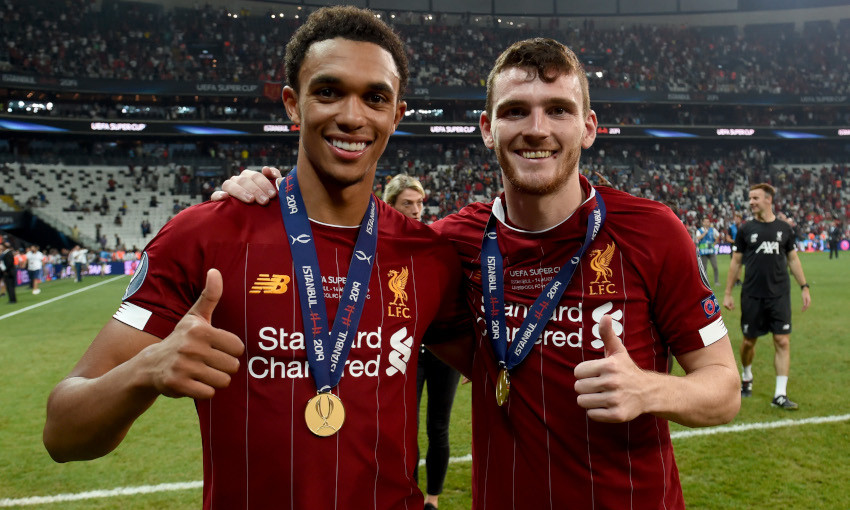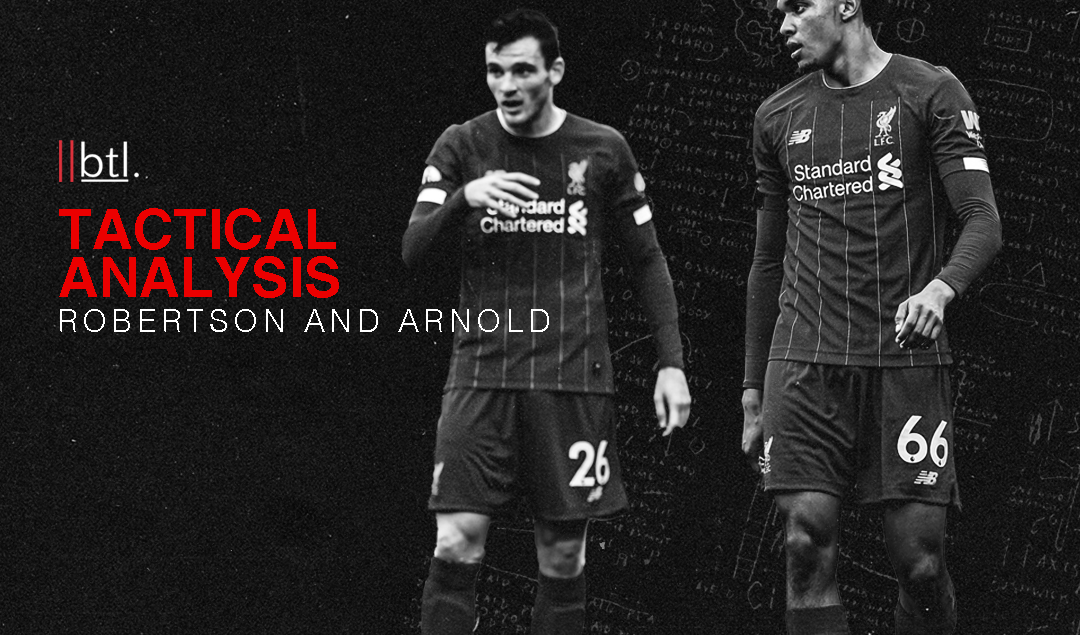Trent Alexander-Arnold and Andrew Robertson: The Deadliest Full Back Duo in Football
Trent Alexander-Arnold and Andrew Robertson have been arguably the best pair of chance creators in world football in the past two seasons, helping Liverpool to the Champions League title last season and, after a 30-year drought, the Premier League title this season.
With defences becoming more and more compact, attacking through the wide areas becomes a good alternative to the traditional “breaking through the centre” approach. The experiment with attacking-minded full-backs on both flanks seems to be paying off, with Alexander-Arnold and Robertson getting 27 and 19 Premier League goal contributions respectively since the start of last season.

Photo: Liverpool FC via Getty
In this article, I will analyse how both Alexander-Arnold and Robertson create chances for their teammates from open play and set-pieces.
Trent Alexander-Arnold
Trent’s ability to put the ball into the box from any given range, regardless whether the ball is moving or not, and to deliver the cross with great precision is unprecedented for a full-back. He completes 7.12 crosses per game in the league and cup competitions, and he constantly tests defenses with his deliveries.
The most frequently occurring pattern is a high cross into the box from the right flank near the penalty area, as in the example below. Mohamed Salah stays out wide, while two other attackers in Roberto Firmino and Sadio Mané, joined by Georginio Wijnaldum, flood the box for the cross.
Despite not having the tallest attackers, Liverpool’s strikers have a good sense of positioning in the penalty area before the pass is played, and that helps them get to the end of many crosses.
When the opposition defence gets too narrow and Alexander-Arnold arrives in the second tempo, he likes to play a powerful low cross into the box, slightly ahead of the defenders for a tap-in.
The power on those can be a problem, as it is very hard to control in motion and with the first touch (for example, Firmino’s miss in February game against Norwich). However, with the right execution and a little bit of luck, these types of deliveries become a powerful weapon for Jürgen Klopp’s side.
Alexander-Arnold’s in-game dynamics with Salah include occasional inward runs in behind from the Egyptian, and the homegrown right back can place the ball right into the pocket between the opposition full-back and centre-back in those situations, as seen below in last season’s match against Huddersfield Town.
The Englishman also loves operating in the half-spaces, and in games against teams that operate with low defensive blocks, he delivers crosses of medium height from that position.
With this kind of positioning, it is easier for him to get the ball after a possible rebound and then have a good opportunity to put the ball into the box again.
In the second leg against Atlético Madrid, Alexander-Arnold tucks in and dictates the game in the half-space, while Jordan Henderson provides cover and Alex Oxlade-Chamberlain provides width.
This is a good example to see how the full-back actually plays in a midfield role, while the midfield player defends space behind like a defender would do.
With defences becoming more compact and narrow, the quick switches of play can be really effective, and, in the case of Liverpool, these diagonal passes from one flank to another have become one of their deadly weapons.
Liverpool grabbed valuable goals against Manchester City and Everton that originated from passes by Alexander-Arnold into Robertson and Mané on the left flank.
Last season, Alexander-Arnold became the first Premier League defender to record 12 assists in a single season. He’s already equalled that tally, and with seven games to go, it’s only a matter of time before he breaks it.
Andrew Robertson
Robertson is a more versatile creator than Alexander-Arnold, possessing other qualities for progressing the ball outside of passing.
The Scotsman utilises his pace much more than Alexander-Arnold, oftentimes picking up the ball in his own half and then making a sprint to enter the final third. Here he makes a run in behind Ismaïla Sarr to open up Watford’s defence.
Robertson is more athletic than his partner from the other flank, especially when it comes to powering through opponents. His strong build and ability to stand firmly even at high speed help him tremendously in those situations, and while he isn’t the best dribbler, he’s got enough close control to make his way through pressure.
His link-up play with Mané consists of the latter drifting wide and creating triangular passing combinations, with Wijnaldum also supporting the two. From there, there are various outcomes: Robertson makes a run in behind like in the shot above, Mané makes a run both down the flank and inwards, Wijnaldum can threaten on goal.
The relationship of Robertson with his teammates down the left flank is significantly different from Alexander-Arnold’s. On the right flank, Salah often drives inwards, creating the space for Alexander-Arnold, while the right central midfielder, usually Henderson, provides cover for both.
On the other hand, Mané doesn’t tuck in as much as the Egyptian does, and starts running towards the penalty area when Robertson gets a good look for a cross. In the example below, Firmino is joined by Salah, while Mané positions himself wide on the flank. Of course, both Mané and Salah play centrally for a considerable part of every game, but it happens in different proportions.
Robertson’s crossing game is not as diverse as that of Alexander-Arnold. For the most part, he crosses the moving ball after a run or a collected rebound. Practically all of his deliveries are inward crosses after he side-foots the ball.
However, despite the simplicity in his approach, his crosses are not inferior to Alexander-Arnold’s in terms of accuracy. He provides a vast variety of crosses from the left flank: to the near post, to the penalty spot and the far post, while doing it on the appropriate height most of the time.
When Robertson is on the brink of the penalty area, he tends to opt for cutbacks, like in the example below. In contrast to Alexander-Arnold, who prefers powerful deliveries that go across the box in these situations, Robertson makes passes that go slightly backwards for the arriving attackers, in this case, Salah.
Just like Alexander-Arnold, Robertson also makes switches of play across the whole pitch, and these passes can progress the ball upfield with great efficiency.
Despite having a different skillset and currently losing the battle of assists to his English partner, Robertson is extremely valuable to Liverpool and provides whole another dynamic to Liverpool’s attacks when he is on the field.
Set-Piece Threat
Outside of the obvious threat that both players possess in open play, Alexander-Arnold and Robertson are the main set-piece takers for the Reds, and having both left and right-footers at their disposal allows them to have inward and outward crosses from both flanks, creating a wide variety of possible corner routines.
Liverpool use simple concepts like blocks, moving opposition players away from the zones and creating space in the six-yard box. The corner routines slightly change for every opponent, but the main patterns resolve around the same principles. One player (usually Mané) runs towards the set-piece keeper to drag away his marker. Another Liverpool player remains in the six-yard box, while the tall Liverpool players such as Virgil van Dijk and Fabinho find themselves in 3v3 situations around the penalty spot.
Below is an example of the variation of Liverpool’s typical corner. As Mané makes a run towards Alexander-Arnold, Salah stays near the goalkeeper, while the 3v3 situation in the centre is created with the help of Firmino, Wijnaldum and Fabinho.
The 3v3 battles consist of intersecting runs and blocks, allowing Liverpool to make great use of both tall players and the players of medium build. Van Dijk and others make crossing runs, and players like Firmino or Wijnaldum oftentimes block opponents from marking Liverpool’s big players.
These intersecting runs make opponents also run in different directions, and a block set by a Liverpool player sometimes can take out several opponents. Liverpool usually have four to six players in the box, with one or two players near the penalty area for collecting possible rebounds. Apart from playing direct crosses in order to diversify corners, sometimes one player comes short for a quick corner.
Left-sided corners often see Robertson come short to help Alexander-Arnold, and if the opposing team has several players defending the short corner, then Liverpool often opt in for a longer play with one more player positioning themself around 20 meters away from the penalty area. Here Norwich have two players guarding Alexander-Arnold and Robertson, so Liverpool play it to Fabinho, who delivers the cross.
Norwich have four players in the six-yard box, so both Mané and Henderson run to the near post in the attempt to free up the space. Van Dijk is the only big player out of four Reds in the box, so he makes a run towards the far post, taking away three players, while Firmino makes a run to the area between the penalty spot and six-yard box.
The whole play was targeted for Firmino in case Alexander-Arnold would decide to cross it in himself, and Liverpool nearly found Firmino free, with only Todd Cantwell coming to the rescue out of the players near the goalkeeper.
Out of Alexander-Arnold’s 12 assists, 5 have come from set-pieces; out of Robertson’s 7 assists, 1 has came from set-pieces. If one of them missed out due to injury or suspension, it would become very easy for teams to manipulate Liverpool’s attacks, as well as handle their set-piece threat.
Having a real threat from only one side of the pitch would draw more attention to that flank, as Liverpool don’t have anyone on the bench with the same amount of creativity. In the recent stalemate against Everton at Goodison Park, Liverpool looked to attack more through the right flank and through the centre due to Robertson’s absence, with Naby Keïta having a big impact going forward.
Liverpool’s stubborn commitment to crosses even if they don’t seem to work (with one of the best examples being the elimination from the Champions League by Atlético) can be explained by several reasons. Regardless of the threat a single cross possesses, it still disrupts the opposition’s defensive shape, and with Liverpool’s generally good sense for rebounds and excellent counter-pressing, it is an effective way to access dangerous areas.
Secondly, crosses usually force the opposition defensive block deeper, which minimises risks of possible counter-attacks and also creates more havoc in the penalty area, as it becomes harder to mark players. Thirdly, attacking through the wings is the safest way to create, because the full backs have more time and less pressure to pick a pass on the flank than they would have when playing more centrally.
Overall, the strategy seems to be working at the end, with Liverpool capable of winning games without changing strategy, even if this strategy didn’t seem to work for the whole game like against Aston Villa previously this season. The chemistry between the team is sensational and the established connections in Liverpool’s attack bear fruit.
Conclusion
Alexander-Arnold and Robertson have become the embodiment of the recent revolution in world football with the growing influence of full-backs on the team’s attacking structure. The likes of Alphonso Davies, Achraf Hakimi and many others play a big part in their teams’ attacks through their pace, passing ability and ultimately, goal contributions. However, no club enjoys a more dangerous full-back duo than Liverpool, and they’ll continue to reap the rewards for years to come.
By: Artyom Osipov
Featured Image: @GabFoligno
